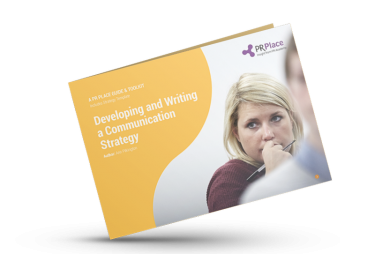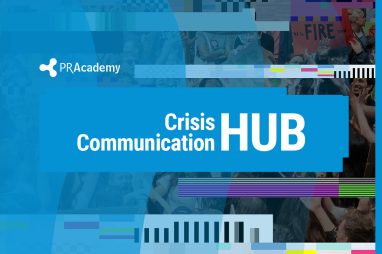Keeping it brief
Is briefing spokespeople to use the ‘correct language’ still effective or is it just an outdated communications tradition?
About the author
Rachel Allen prepared this article for a CIPR Professional PR Diploma assignment while studying with PR Academy


The pandemic has reminded us of a thing or two about language. One of those things is the importance of being careful with words, both spoken and written, especially about health matters.
Government ministers were warned to avoid ‘extravagant wordplay’ in the midst of the pandemic last year. Concerns were raised by scientific advisors about the use of new jargon, like ‘bubble’, especially for those whose first language isn’t English, at a time when people were being asked to limit contact with others.
Former BBC Newsnight presenter Emily Maitlis noted that ‘language around COVID-19 has sometimes felt trite and misleading’ and that ‘the disease is not a great leveller’ as had been suggested by Government ministers when Prime Minister Boris Johnson contracted the disease.
This is a strong reminder of how important it is to be careful with the language we use around health matters, as outlined in Nature during the pandemic.
However, at a time when misinformation and fake news threatened to derail public health guidance on COVID-19 – culminating in the Stop the Spread campaign from the World Health Organisation (WHO) and the UK government – careful consideration needs to be given to how communicators brief their spokespeople.
Traditionally briefing involves informing or reminding people of key messages and the right language to use (plus the words to avoid). However, by effectively putting words in a spokesperson’s mouth is this at the expense of authenticity?
Not if you take the time to do it properly with the right spokespeople.
For people with lived experience of a condition (or consumers of a product), tailoring key messages to their personal experience can deliver great results thanks to the authenticity of their own story.
For experts, retaining authenticity and connecting with the reader is a slightly different matter, especially when you add misinformation into the mix. As 67% of people fear fake news and 6 out of 10 people say their default tendency is to distrust something until they see evidence to the contrary, according to the Edelman Trust Barometer 22, it is important for spokespeople and their organisations to get it right.
Based on some of the conflicted messaging and rhetoric we’ve seen coming out of senior Government officials’ mouths it’s clear that briefing-in does still have a place in our toolkit.
However, the key to a great toolkit is in the effectiveness of its tools, and all tools need honing periodically to ensure they’re still fit for purpose.
So, the way we brief our spokespeople and encourage the right kind of language should be reviewed regularly for efficacy and accuracy.
What’s in a word?
Language matters if we want to change views, and ultimately behaviours, towards any major health issue – the pandemic has shown us that.
In health communications the correct use of language can tackle the fatalism or fear towards a condition. Empowering people to use the right words to describe a disease or condition can tackle stigma, in particular ‘invisible’ health issues such as neurological and mental health conditions.
For the right words to stick you need to be clear and consistent in what you say, especially if you expect action to be taken as a result.
So, your messaging is consistent but is it accessible? If it isn’t, you will be failing to reach those who are disproportionately affected by chronic health conditions. You could also be compounding health inequalities that already exist.
One in 6 adults in England are deemed to have very poor literacy levels so your spokesperson needs to leave their jargon in the textbooks and speak in plain English.
This was brought to the surface during the height of the pandemic.
The COVID-19 ‘infodemic’ showed poor health literacy is an underestimated public health problem globally. In Europe, almost half of adults reported having issues with health literacy and not having competencies to care for themselves or others.
It is also important to consider potential language barriers your audience may have if English is not their first language. This is key if you want to improve your cut-through to those who need it most.
Turning words into action
Many of us could be forgiven for thinking our main objective is raising awareness of our cause – but what action do you want your audience to take as a result of ‘raising awareness’?
Ensuring you have this outlined from the start is key for measurement and evaluation at a later date, neatly outlined in AMEC’s Barcelona Principles 3.0.
What if you’re looking for a change in behaviour? How do we select and brief people to influence a change, not just in attitudes but ultimately behaviours as well?
PR expert Patrick Jackson and his colleagues outlined how to get there in five steps.
The first steps involve building awareness and then developing latent readiness – once the messaging has reached the audience, they start to form opinions which makes them more inclined to make changes.
The remaining steps involve a desire to change which leads to exploration of new behaviour, for example, reducing the amount of meat in your diet while deciding whether to become a vegetarian or adopt meat-free days.
To get to this point, you need to have been presented with a persuasive argument or campaign.
Persuasive communications can be the difference between a successful campaign and one that falls flat. This is where considering who you are really talking to comes in.
As more companies are taking the time to look at stakeholder segmentation, considering who you want to reach with your messaging should form part of any briefing process. Does your audience know about the problem (active) or are they in need of information but aren’t engaged with your cause (latent) as outlined by James Grunig?
So, you have considered who you are talking to but have you thought about how they think? Research into processing messages has unlocked some interesting findings.
One of the leading pieces of work in this area is the Elaboration Model of Persuasion from Richard E. Petty and John T. Cacioppo. It suggests that people process information in two ways, either with a great deal of thought which is called the ‘central route’ or by putting little thought or effort into analysing a message, known as the ‘peripheral route’.
In essence there are pros and cons to both, so it pays to know your target audience when picking a spokesperson.
Those using the central route tend to become invested in a topic, exploring it in detail, while those who process messaging using the peripheral route may not feel they have a vested interest in the subject but they do treat experts as a trusted source.
The best person for the job
Now we all have a favourite spokesperson, that one person you can rely on at the drop of a hat for a quick-turnaround broadcast interview. They are worth their weight in gold but if you have time on your side, you should take a step back and really consider who is the best person for the job.
Finding the right person to convey a message is likely to determine whether that message is well received or not (and if your communications really are persuasive).
Likeability and authority are just two of six factors you should consider according to Robert Cialdini, Regents’ Professor Emeritus of Psychology and Marketing at Arizona State University.
Likeability feels quite personal when considering who to choose and how they will be received but a personable expert who doesn’t alienate your audience with jargon and/or someone with lived experience of the subject (a case study) they can relate is a great combination.
Ensuring your spokesperson knows their stuff will give them the authority they need for people to trust what they say. Remember those who process messages using the ‘peripheral route’ put their trust in experts and those using the central route thrive on the detail.
Another of Cialdini’s principles is ‘social proof’ which plays to people’s sense of ‘safety in numbers’. Someone with experience of a condition, situation, or product adds confidence to a story.
Clearly there are only a finite number of people you can call on for any particular communications request or campaign, but it is worth thinking is my expert the best fit for this or is there someone who resonates better with the audience or subject?
A person with lived experience offers authenticity to a subject and bridges the gap we sometimes have, between the stakeholder and our internal spokesperson.
If you get the chance to offer up a package then you can offer up both an expert who can offer authority and a case study who can provide relatability, especially if you work in the medical research sector as I do.
Cialdini also talked about the importance of consistency and commitment, which go hand-in-hand. If someone commits to your cause by signing a petition or signing up to a newsletter it is in their human nature to be consistent. So, if you want your message to stick and ultimately attitudes to change you need to deliver your message more than once and consistently.
“You need to be everywhere. And for people you reach multiple times through different mediums, you need to make sure your message is consistent… Messaging needs to be aligned at every level”, says David Plouffe, Barack Obama’s 2008 campaign manager, from The Audacity to Win.
So, it’s clear we need to take the time to do things right. It really is all in the planning and brief – get this right and it could pay dividends in the future.
If you are aiming for a new audience who may not be aware of your cause or brand then do your research, consider whether you have the knowledge about the audience you are looking to target and the right people for the job.
Spending time developing your ‘arsenal’ of spokespeople is something worth doing – whether they are temporary or permanent spokespeople doesn’t really matter as long as you brief them well.
Having trained spokespeople in target communities ensures you have the right representatives needed to build trust for communications messages to be received.
The team behind the 2021 Census communications strategy did just that. They prioritised accessibility and inclusivity in messaging, with the support of a diverse group of spokespeople (including more than 200 members of the public) to deliver the results.
The campaign, with the strapline ‘build back better’, set out with an aim of achieving a 75% response rate but due to the multifaceted approach to its inclusive communications they ended up achieving over 97%.
These results painted an accurate picture of our society that has paved the way for planning public services to meet the needs of all over the next 10 years.
Don’t underestimate the power of a good brief and an even better spokesperson.
Doing it right:
- Know your audience
Who your audience is will inform who your spokesperson should be and help tailor your messaging. If you want your communications to be effective decide whether you want to focus on one group of stakeholders or more as the latter will require more work to tailor your communications to each audience or outlet.
- Pick the right person for the job
Choose the most appropriate spokesperson – remember authority, likeability, consistency. Where possible, choose a combination of an expert and a person with lived experience (or a consumer).
- Tailor your messaging – be inclusive
- Consider the kind of language you should use for your chosen audience.
- Don’t use jargon.
- Never assume the audience are experts on your chosen subject.
- Three really is the magic number: pick no more than three key messages.
- Be consistent
Once you have your spokespeople lined up make sure they are all singing from the same hymn sheet. Remember ‘messaging needs to be aligned at every level’.


